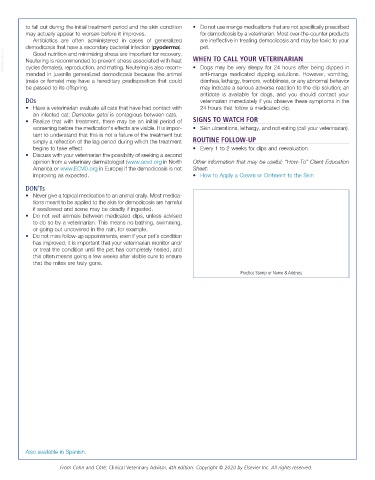Page 2971 - Cote clinical veterinary advisor dogs and cats 4th
P. 2971
to fall out during the initial treatment period and the skin condition • Do not use mange medications that are not specifically prescribed
may actually appear to worsen before it improves. for demodicosis by a veterinarian. Most over-the-counter products
Antibiotics are often administered in cases of generalized are ineffective in treating demodicosis and may be toxic to your
demodicosis that have a secondary bacterial infection (pyoderma). pet.
VetBooks.ir Neutering is recommended to prevent stress associated with heat WHEN TO CALL YOUR VETERINARIAN
Good nutrition and minimizing stress are important for recovery.
• Dogs may be very sleepy for 24 hours after being dipped in
cycles (females), reproduction, and mating. Neutering is also recom-
mended in juvenile generalized demodicosis because the animal anti-mange medicated dipping solutions. However, vomiting,
(male or female) may have a hereditary predisposition that could diarrhea, lethargy, tremors, wobbliness, or any abnormal behavior
be passed to its offspring. may indicate a serious adverse reaction to the dip solution; an
antidote is available for dogs, and you should contact your
DOs veterinarian immediately if you observe these symptoms in the
• Have a veterinarian evaluate all cats that have had contact with 24 hours that follow a medicated dip.
an infected cat; Demodex gatoi is contagious between cats.
• Realize that with treatment, there may be an initial period of SIGNS TO WATCH FOR
worsening before the medication’s effects are visible. It is impor- • Skin ulcerations, lethargy, and not eating (call your veterinarian).
tant to understand that this is not a failure of the treatment but
simply a reflection of the lag period during which the treatment ROUTINE FOLLOW-UP
begins to take effect. • Every 1 to 2 weeks for dips and reevaluation.
• Discuss with your veterinarian the possibility of seeking a second
opinion from a veterinary dermatologist (www.acvd.org in North Other information that may be useful: “How-To” Client Education
America or www.ECVD.org in Europe) if the demodicosis is not Sheet:
improving as expected. • How to Apply a Cream or Ointment to the Skin
DON’Ts
• Never give a topical medication to an animal orally. Most medica-
tions meant to be applied to the skin for demodicosis are harmful
if swallowed and some may be deadly if ingested.
• Do not wet animals between medicated dips, unless advised
to do so by a veterinarian. This means no bathing, swimming,
or going out uncovered in the rain, for example.
• Do not miss follow-up appointments, even if your pet’s condition
has improved; it is important that your veterinarian monitor and/
or treat the condition until the pet has completely healed, and
this often means going a few weeks after visible cure to ensure
that the mites are truly gone.
Practice Stamp or Name & Address
Also available in Spanish.
From Cohn and Côté: Clinical Veterinary Advisor, 4th edition. Copyright © 2020 by Elsevier Inc. All rights reserved.

